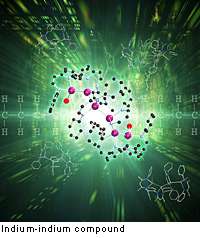New potential for inorganic materials after metal forms unexpected bonds

The research, published in last week's Science, shows that it is possible to create extended chains of indium-indium single bonds. This is surprising because the ability to form bonds between like elements was thought to be largely confined to elements, such as carbon, which are found in group 14 of the periodic table. All living systems and most polymers are carbon based and this is partly because of the element's ability to form these bonds.
The new indium compound, created by researchers at Imperial College London and the University of Sussex, has an unusual electronic structure that opens up possibilities for designing polymers based on group 13 of the periodic table, where indium is found.
The researchers believe these electronic properties could allow group 13 polymers to be used to create new versions of electronic devices which are usually dependant upon entirely solid semiconductors. Examples include light emitting diodes (LEDs) and solar cells.
A soluble polymer based on indium might be simply sprayed on as a solution, removing the need to use the inconveniently high temperatures and low pressures that are required when making entirely solid-state electronic devices.
Dr Mike Hill, in the Department of Chemistry at Imperial College London and lead author of today's paper, said: "The compound that we made was unexpectedly stable and it was very simple to create. It opens up another box for finding solutions to a host of problems.
"If you think of the elements in the periodic table as a set of paints, people tend to use only certain colours from the palette. Here, were using shades that arent normally used. This opens up possibilities in terms of the way we can start to control these natural elements and make them work for us in ways that they wouldnt do in nature," he added.
The researchers created the indium compound through an exchange reaction between indium monoiodide and a potassium derivative. They now intend to study the molecules in much more depth to see if they are able to create longer and shorter chains of group 13-group 13 single bonds and ultimately create stable polymers.
Citation: "A linear homocatenated compound containing six indium centers", Science, 30 March 2006, Michael S. Hill, Peter B. Hitchcock, Ruti Pongtavornpinyo
Source: Imperial College London















